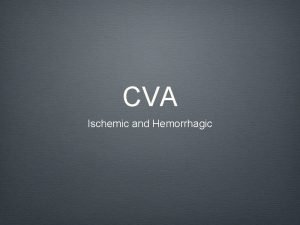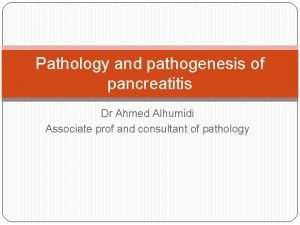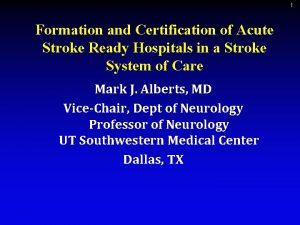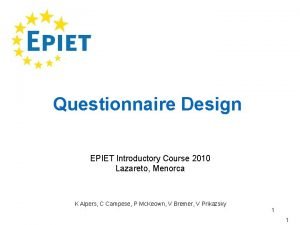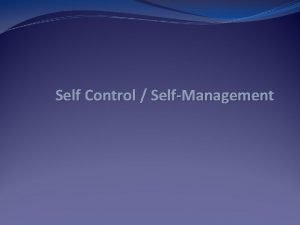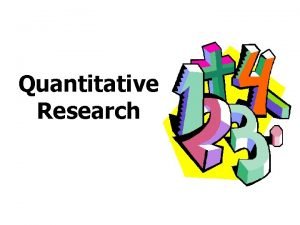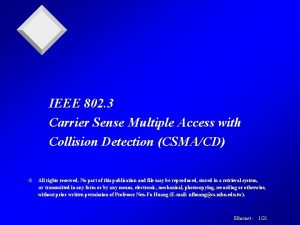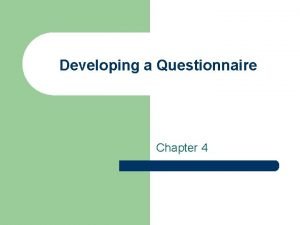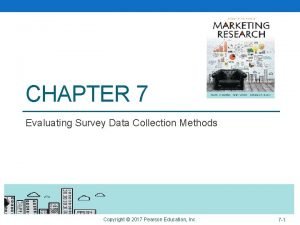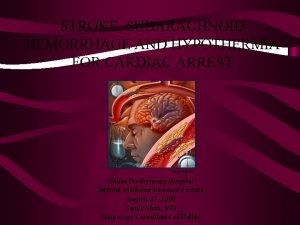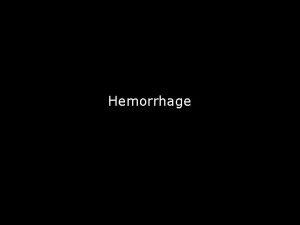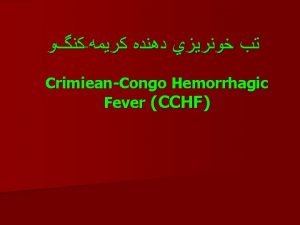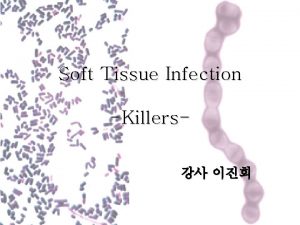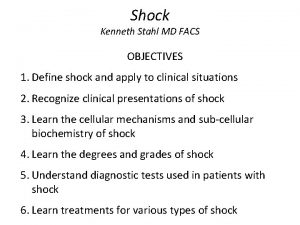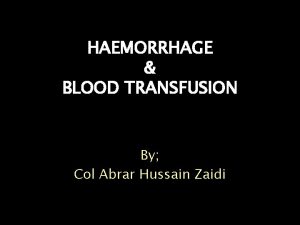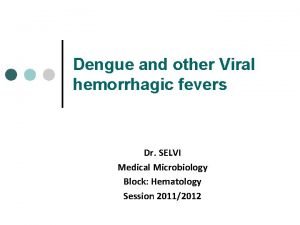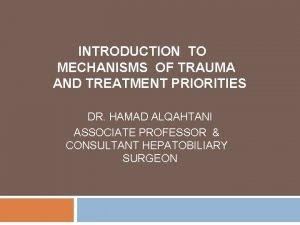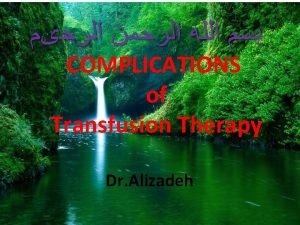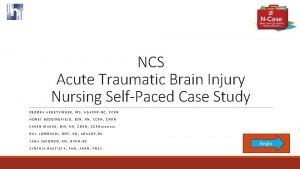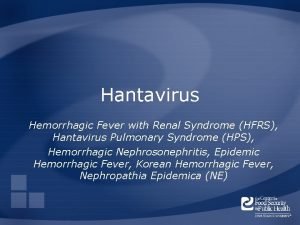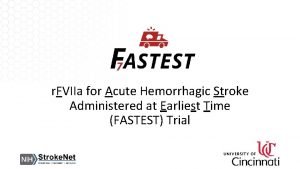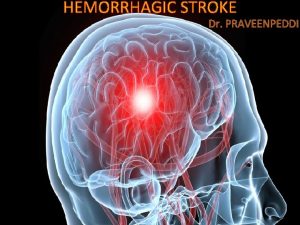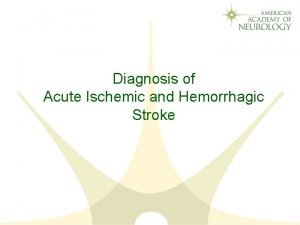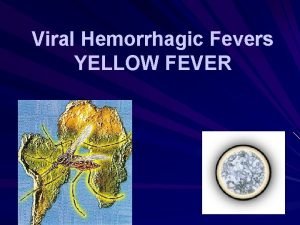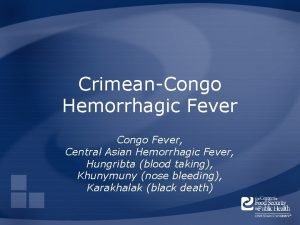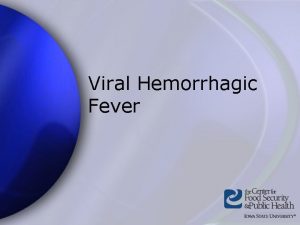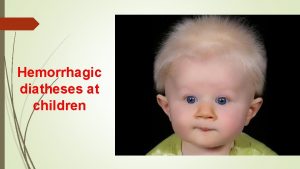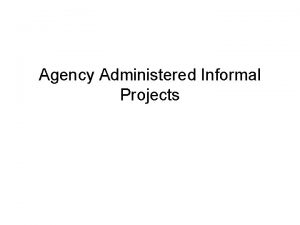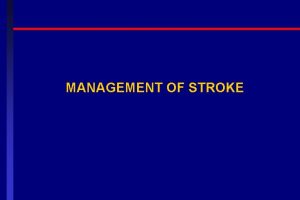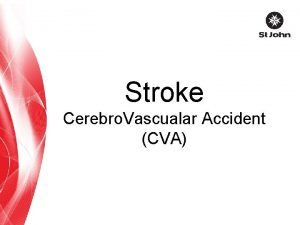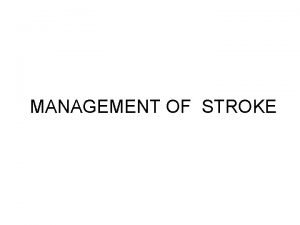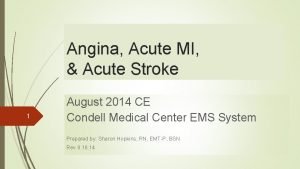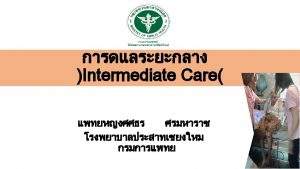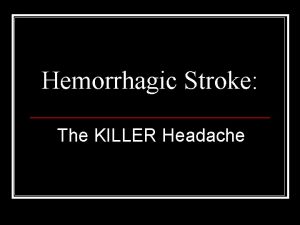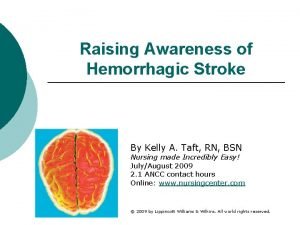r FVIIa for Acute Hemorrhagic Stroke Administered at








































- Slides: 40

r. FVIIa for Acute Hemorrhagic Stroke Administered at Earliest Time (FASTEST) Trial

Webinar Agenda 1: 30 pm – 2: 00 pm FASTEST Trial Overview Joseph Broderick, MD 2: 00 pm – 2: 10 pm Exception from Informed Consent (EFIC) Overview Pooja Khanolkar, MPH 2: 10 pm – 2: 30 pm Q&A All August 26, 2020

Outline for the Webinar • Discuss what is a brain hemorrhage or intracerebral hemorrhage (ICH) • Explain what is recombinant Factor VIIa (r. FVIIa) • Explain the FASTEST Trial and what it is trying to accomplish • Discuss what is emergency research and consent (Exception from Informed Consent (EFIC))

What is a Brain Hemorrhage?

ICH: Old or Damaged Blood Vessels Break Under Pressure

Background • Brain hemorrhage or intracerebral hemorrhage (ICH) is a type of stroke that accounts for more than 10% of the estimated 17 million strokes worldwide each year, or about 1, 700, 000 cases per year • More than 40% of patients die and only 20% of survivors are functionally independent at 6 months • The amount of blood in the brain is the most important determinant of outcome, and most bleeding occurs within 2 -3 hours • There is no scientifically proven effective treatment for ICH

SIZE MATTERS! Small Increases in ICH Volume Cause Significant Increase in Mortality Ping-pong ball vs. Golf ball 31 m. L 41 m. L ICH (N=188) Overall mortality 44% 0 -29 cm 3 Mortality 19% 30 -60 cm 3 Mortality 20%-55% ≥ 60 cm 3 Mortality 91% Only 1 of 71 patients with ICH volume ≥ 30 cm 3 functioned independently at 30 days (Oxford Handicap Score ≤ 3) Broderick, Stroke. 1993; 24: 987 -993

Learn from patients, your wife, and your colleagues J. Neurosurg: 72: 195 -199, 1990

Learn from patients, your wife, and your colleagues • Ellipsoid volume 4/3π(A/2)(B/2)(C/2) • ABC/2

Early hemorrhage growth in patients with ICH • First prospective study of ICH growth • 103 patients scanned < 3 hours of onset • 38% experienced significant hematoma growth (> 33% increase in volume) • 26% between baseline and 1 -hour scan • 12% between 1 - and 20 -hour scan • ICH growth was associated with clinical deterioration on NIHSS Brott, Broderick, et al 1997, Stroke. 1997; 28: 1 NINDS funded study

Physiologic time is critical for hemostatic therapy Salman et al, Lancet Neurology, September, 2018 – Figure A, demonstrates the strong exponential relationship between time from onset and predicted probability of growth of ICH of > 6 cc.

Current treatment of ICH • Admission to intensive care unit • Treatment of blood pressure, which is often very elevated • Often ventilator machine to help breathe • Medical and surgical treatments to help relieve pressure in the brain • Occasionally, surgery to remove blood • There is no scientifically proven effective treatment for ICH

Medications that Plug Leak: PPC in Warfarin-ICH (INCH Trial) Outcome FFP N=23 PCC N=27 P-value INR<2 within 3 hours 2 (9%) 18 (67%) 0. 003 Death at 90 days 8 (35%) 5 (19%) 0. 14 ICH expansion at 24 hours (ccs) 22. 1 (27. 1) 8. 3 (18. 3) 0. 048 >33% expansion at 24 hours 12/20 (60%) 8/27 (30%) 0. 024 Steiner, et al. Lancet Neurology, 2016

What is recombinant Factor VIIa (r. FVIIa)? • Factor VIIa is a normal protein in our body that helps stop bleeding • Recombinant Factor VIIa (identical to Factor VIIa but given in much larger amounts) is the only medication that has been shown to substantially decrease bleeding in patients with hemorrhage in the brain • It is easily administered intravenously with rapid onset of action • It is approved for other medical indications that involve bleeding (hemophilia) but not for brain hemorrhage • Prior trials of r. FVIIa showed that it slowed bleeding in the brain but that its benefits in improving outcomes are most likely when given within 2 hours of onset of symptoms

r. FVIIa Accelerates and Strengthens Local Hemostasis via a Unique Mechanism of Action 1. INITIATION: Tissue Factor/FVIIa interaction leads to thrombin generation 2. AMPLIFICATION: r. FVIIa activates Factor X on the surface of activated platelets, leading to an enhanced thrombin burst at the site of injury 3. FIBRIN CLOT FORMATION: Thrombin converts fibrinogen into fibrin, producing a stable clot Hoffman, M, et al. Thromb Haemost 2001; 85: 958.

Potential risks of r. FVIIa in patients with ICH • Since r. FVIIa helps stop bleeding by stimulating formation of and enhancing blood clots, patients with brain hemorrhage are also at risk for other vascular diseases and blood clots where there are damaged blood vessels – there is a risk of heart attack, stroke due to blockage of brain arteries, and clots in the lung • In prior studies, this occurred about 5% more commonly in persons treated with r. FVIIa as compared to placebo

Estimated Mean Percent Change in ICH at 24 Hours: Phase 2 b Trial 29% P=0. 012* 16% P=0. 015* 14% 11% Placebo 40 µg/kg 80 µg/kg 160 µg/kg Combined Treatment Covariates include baseline ICH volume, time-to-CT, and CT-to-needle time

Kaplan-Meier Survival Curves: Phase 2 b Trial P=0. 02, r. FVIIa combined vs. placebo New Engl J Med 2005; 352: 777 -785

Modified Rankin Scale at Day 90: Phase 2 b Trial 160 µg/kg 80 µg/kg m. RS 0 -1 m. RS 2 -3 m. RS 4 -5 m. RS 6 40 µg/kg Placebo 100% 80% FULL RECOVERY 60% 40% 20% 0% DEATH Global adjusted odds ratio for improvement on m. RS 2. 2, P=0. 004 New Engl J Med 2005; 352: 777 -785

Difference From Placebo in Absolute ICH Growth at 24 Hours (m. L) FAST Trial: Absolute Reduction in ICH Growth (m. L) 80 µg/kg by Treatment Time <2 Hours <3 Hours <4 Hours

FAST Trial: Modified Rankin Scale – Distribution at Day 90 No Difference Between Treatment Groups

Post-hoc analysis of subgroup from FAST Trials Mayer et al, Stroke, 2009

FASTEST subgroups from FAST and Phase 2 b studies Minutes from onset to treatment in patients age ≤ 80 ≤ 150 ≤ 140 ≤ 130 ≤ 120* Minutes from onset to treatment in patients age ≤ 70 ≤ 150 ≤ 140 ≤ 130 ≤ 120 FAST m. RS 0 -2 FVIIa m. RS 0 -2 Placebo 42% 46% 49% 52% 41% 41% 38% m. RS 0 -2 FVIIa 53% 59% 62% 69% Absolute % in m. RS 0 -2 in favor of r. FVIIa at 90 days 0% 5% 9% 14% Absolute % in m. RS 0 -2 -2 in favor of r. FVIIa Placebo at 90 days 39% 14% 38% 21% 38% 24% 33% 36% *N=25 in FVIIa and 32 in placebo group Phase 2 b Minutes from Absolute % in m. RS 0 onset to m. RS 0 -2 2 in favor of r. FVIIa at treatment in FVIIa Placebo 90 days patients age ≤ 80 ≤ 150 42% 32% 10% ≤ 140 47% 30% 17% ≤ 130 50% 25% ≤ 120 50% 20% 30%

FASTEST Trial: Objective • The objective of the r. FVIIa for Acute Hemorrhagic Stroke Administered at Earliest Time (FASTEST) Trial is to establish the first treatment for acute ICH within a time window and subgroup of patients that is most likely to benefit NIH Funded: 1 U 01 NS 110772 -01

Design • Randomized, double-blind controlled efficacy trial of r. FVIIa plus best standard therapy vs. placebo plus best standard therapy (including INTERACT 2 goal of target systolic blood pressure of 140 mm Hg) • Includes patients: • Age 18 -80, inclusive • Baseline volume of spontaneous ICH ≥ 2 cc and < 60 cc (measured by ABC/2 or by an FDA-cleared automated ICH volume imaging software (e. g. , VIZ. ai)) • No or small volume of IVH (IVH score ≤ 7) • Treated within 120 minutes of stroke onset/last known well (goal: ½ treated within 90 minutes)

Who does not qualify for FASTEST? • Persons who already are in a deep coma, or who have very large areas of bleeding in the brain and are already destined to die • Persons with recent heart attacks, strokes, or blood clots (within the prior 3 months) • Persons on blood thinners, such as warfarin • Women known to be pregnant • Persons who have an opt-out card

How to Minimize Time to Treatment • Exception from Informed Consent (EFIC) • Including remote and e. Consent options in the event a legally authorized representative or family member is available to provide prospective consent • Mobile stroke units (MSUs) • Improved acute stroke treatment processes, as for ischemic stroke, including automated calculation of ICH volume, door to needle, etc.

Intervention • Randomize participants in a 1: 1 ratio to intravenous r. FVIIa or placebo at a dose of 80 µg/kg (maximum 10, 000 µg or 10 mg) and administered intravenously over 2 minutes – all investigators and participants will be blinded throughout the course of the trial • Enrollment and randomization in the trial will occur upon injection of the study medication • Only a baseline non-contrast CT is required • CT angiogram will be collected, if done, but is not required

Additional Key Study Procedures • Participants will receive AHA guideline-supported management of acute ICH; acute blood pressure management with a target systolic blood pressure of 140 mm Hg is required • Participants will get another CT of the head within 24 hours from stroke onset/last known well to measure if there was hemorrhage growth • Participants will have follow-up visits remotely at Day 30 and Day 90 and in-person at Day 180

Primary Outcome • The primary outcome measure is the following distribution of the ordinal m. RS at 180 days: 0 -2, 3, and 4 -6

Study Population • Number of subjects to be enrolled: 860 • Approximate number of trial sites: 100 hospitals, including 15 mobile stroke units • Countries participating: U. S. , Canada, Germany, Spain, U. K. , and Japan • Target FPFV: October 1, 2020 • Target recruitment period: 3½ years

FASTEST Trial Funding and Leadership • NINDS approved funding; also, additional funding approved in Japan • r. FVIIa/placebo and histidine solvent provided by Novo Nordisk A/S • Protocol PIs: Joseph Broderick (contact PI), James Grotta, Andrew Naidech, Jordan Elm (statistical PI) • National PIs: Dar Dowlatshahi (Canada), Thorsten Steiner (Germany), Carlos Molina (Spain), Nikola Sprigg (U. K. ), Kazunori Toyoda (Japan) • Independent Medical Safety Monitor: Stephan Mayer

How are emergency studies different? • In most studies, investigators describe what will happen, discuss potential risks and benefits, answer questions, and then eligible patients decide whether or not to participate – the process of informed consent • In emergency studies, such as FASTEST, eligible patients cannot make a decision if they want to participate due to their medical condition, and treatment is needed to be started often before the patient’s legally authorized representative or family member is available to decide for the patient

So how do we do emergency research? • Specific federal regulations allow for exception from informed consent for emergency research (EFIC) only when: • The condition under study is life-threatening • Existing treatments are unproven or inadequate • There is potential benefit for participants • Informed consent cannot feasibly be obtained

Additional Details in the FDA Guidance https: //www. fda. gov/media/80554/downloa d

Two Components of EFIC: Community Consultation & Public Disclosure • Community Consultation (CC) - Who is the community? 1) The community in which research will take place • Geographic area (i. e. , hospital’s catchment area) 2) The community from which participants will be drawn • People likely to suffer from spontaneous intracerebral hemorrhage (ICH) (i. e. , those “at-risk”) - What is consultation? • Solicit input from and inform the community about the trial and EFIC • Methods*: Presentations at existing meetings, focus groups, individual interviews, etc. (*in light of COVID-19, remote/ online CC is highly encouraged)

Two Components of EFIC: Community Consultation & Public Disclosure • Public Disclosure (PD) - Who is the public? • Same as the community - What is disclosure? • Disseminate information to the community about the trial and EFIC • Methods: Social media postings, newspaper ads, brochures, flyers, etc.

Two Components of EFIC: Community Consultation & Public Disclosure • Public Disclosure (PD) - Who is the public? • Same as the community - What is disclosure? • Disseminate information to the community about the trial and EFIC • Methods: Social media postings, newspaper ads, brochures, flyers, etc. • Sites that share a community are highly encouraged to work together while developing and implementing their EFIC plans

Questions?

PLAN Site e-mails Site-Specific EFIC Plan to NCC Site develops Site-Specific EFIC Plan Sites can complete the CIRBI Investigator Application in parallel. Site notifies NCC when all CC and PD is complete and data is submitted Advarra provides feedback to site on Site-Specific EFIC Plan via CIRBI Advarra reviews Site. Specific EFIC Plan It is strongly recommended that Advarra’s feedback is incorporated into the plan before it is implemented. A response to Advarra’s feedback in CIRBI is required after the plan is implemented. REPORT For each community consultation (CC) and public disclosure (PD) event or activity, a corresponding CC Form or PD Form is to be completed in Web. DCUTM. A Local Context Form is also to be completed in Web. DCUTM. NCC e-mails signed Site. Specific EFIC Plan to site NCC signs Site -Specific EFIC Plan Changes can be requested. IMPLEMENTATION Site implements Site-Specific EFIC Plan NCC reviews Site-Specific EFIC Plan NCC works with NDMC to generate a Site EFIC Report from the sitesubmitted data Clarifications, etc. can be requested to data submitted. Site submits Investigator Application, including signed Site-Specific EFIC Plan, in CIRBI Site uploads signed Site. Specific EFIC Plan to CIRBI Sites receive first site start-up payment upon submission of Site-Specific EFIC Plan to Advarra. NCC e-mails signed Site EFIC Report to site Site uploads signed Site EFIC Report and responds to Advarra’s feedback in CIRBI Site action Advarra reviews entire Investigator Application (including signed Site EFIC Report), and decides on site c. IRB approval NCC action Advarra action v 1. 0
 Hemorrhagic vs ischemic stroke symptoms
Hemorrhagic vs ischemic stroke symptoms Pathology of pancreatitis
Pathology of pancreatitis Anterior stroke vs posterior stroke
Anterior stroke vs posterior stroke Acute ischemic stroke algorithm
Acute ischemic stroke algorithm Acute stroke ready certification
Acute stroke ready certification Self-administered questionnaire
Self-administered questionnaire Self control images
Self control images Self-administered questionnaire
Self-administered questionnaire Locally administered address
Locally administered address What is self administered survey
What is self administered survey Survey method of data collection
Survey method of data collection Hemorrhagic transformation mri
Hemorrhagic transformation mri Blood loss classification
Blood loss classification Cchf
Cchf Necrotizing fasciitis hemorrhagic bullae
Necrotizing fasciitis hemorrhagic bullae Hemorrhagic shock classification
Hemorrhagic shock classification Types of haemorrhage
Types of haemorrhage Causes of viral hemorrhagic fever
Causes of viral hemorrhagic fever Stages of hemorrhagic shock
Stages of hemorrhagic shock Hemorrhagic diathesis
Hemorrhagic diathesis Neurocritical care society
Neurocritical care society Lowgrade fever
Lowgrade fever Hemorrhagic fever with renal syndrome
Hemorrhagic fever with renal syndrome Antihemorrhagic vitamin
Antihemorrhagic vitamin Atmosfr
Atmosfr Referatmarkering
Referatmarkering Karttecken ruin
Karttecken ruin Var finns arvsanlagen
Var finns arvsanlagen Verifikationsplan
Verifikationsplan Rbk mätning
Rbk mätning Formel för lufttryck
Formel för lufttryck Densitet vatten
Densitet vatten Elektronik för barn
Elektronik för barn Tack för att ni har lyssnat
Tack för att ni har lyssnat Smärtskolan kunskap för livet
Smärtskolan kunskap för livet Vad är ett minoritetsspråk
Vad är ett minoritetsspråk Luftstrupen för medicinare
Luftstrupen för medicinare Trög för kemist
Trög för kemist Magnetsjukhus
Magnetsjukhus Samlade siffror för tryck
Samlade siffror för tryck Adressändring ideell förening
Adressändring ideell förening
